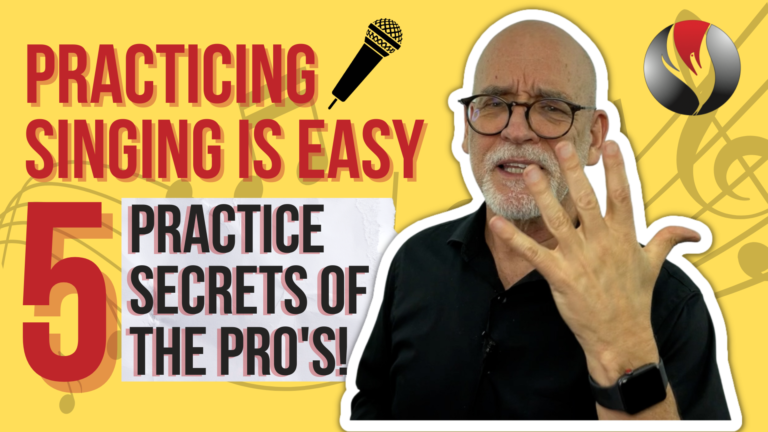Can a Bass Sing High Notes? Yes! Altos Too. 3 Simple Exercises!
Can a bass sing high notes? Yes, and altos too. Here are 3 simple vocal exercises that can add an octave to your range. I know because I’m a bass and my range increased more than an octave. Watch!
Hi I’m Chuck Gilmore, International Vocal Coach and Founder of Power To Sing.
Each week I teach you lessons in vocal technique so you can build a powerful and confident singing voice.
When I was young I got so discouraged with my voice I went 24 years without singing a solo. My main problem was I was a bass and I couldn’t sing past the E above middle C.
It wasn’t until I was 43 years old that I discovered how to sing past the E. But I didn’t stop there, eventually I added more than an octave to my range.
In this video, I’m going to show you 3 exercises that can immediately add an octave or more to your singing.
If you’re new to my channel, please like this video, subscribe and click the bell so you’ll be notified when I post videos weekly!
I’m going to show you exactly how to use these exercises to increase your range.
I’m also going to show you how high I can sing. Of course I can do it in falsetto. However, today I will sing in a connected head voice. So be sure to watch to the end of the video.
Exercise One – Bubble Lips
This may seem too childish and simple because even my seven year old granddaughter does this one. But don’t let it fool you. It’s profoundly powerful. I’ll teach you how to do it and then I’ll explain why it’s so powerful in helping you increase your range.
Make a frown and put your fingers in your frown lines below your lips and push your cheeks upward like this. While saying “uh”, blow air through your lips so they bubble like this. [Demo]
Your lips should be free and easy. Let them bubble as slow and possible. [Demo] Not like this. [Demo]
Men, now do the bubble lips on this 1½ scale like this. [Demo] Now it’s your turn guys then the ladies will follow.
Ready, men. Begin [Bb2 to Db3] Ladies, yours sounds like this: [Demo] Ready, ladies. Begin. [E3-F#4]
Immediately you feel the vibrations move from your chest, into your head and back down to your chest. Take care that you are not letting the tone break into falsetto. You want the tone to stay connected as you ascend in pitch like this. [Demo]
When you do this as demonstrated, three things happen:
First, when you maintain a connected tone, you’re increasing your singing range automatically.
Second, the vocal cords are adjusting appropriately. The muscles in the vocal cords are staying engaged just enough to keep the tone consistent from chest to head voice and back to chest.
Third, with the tone connected, you are beginning to feel what it feels like to sing through the first bridge of the voice and into head voice.
Fourth, you are increasing your range without straining, cracking or breaking. This is the exact condition you use when singing higher into head voice.
If you struggle with any of these exercises, that’s normal. It takes a while to forget old bad habits and develop new muscle memory that makes it easier.
One important step you can take is to discover your vocal type. Your vocal type is not whether you are soprano, alto, tenor or bass. Your vocal type describes what your voice does as you sing from your low to your high notes.
Why is this important to know? Once you know your vocal type, you can do exercises for what YOUR voice needs. The exercises for your vocal type will help eliminate problems and immediately improve your technique, including increasing your range.
Go to PowerToSing.com/test. Take the vocal test and get your vocal type. Within minutes you’ll receive an email giving you your vocal type. Then click on the free mini vocal course about your vocal type and get a bunch more great exercises tailored to your voice to speed up your progress.
The link to the vocal test is here or you can find it in the description below this video.
Exercise Two – Exaggerated Ney
Men, this exercise sounds like this. [Demo] Hear the exaggeration? Hear how quiet I did it. Guys you do it first and then the ladies. Ready men. Begin. [Octave Repeat. A3 down to E3]
Ladies, it sounds like this. [Demo] Ready ladies. Begin. [Oct. Repeat. C#4 down to A3]
Remember to do this exercise very quietly. [Demo] Just loud enough to keep the tone connected. Do it with a little exaggeration. Once you’re able to do the exercise with a connected tone, discontinue the exaggerated tone.
This exercise reduces the heaviness of the chest voice on the low notes and deepens the vocal connection on the high notes so you don’t go into falsetto. Adding the exaggerated tone also helps keep the tone connected so you don’t break into falsetto.
Exercise Three – Mum
This exercise sounds like this. [mum with a cry]. Guys you do it first and then the ladies. Ready men. Begin. [Octave Repeat. A3 down to E3]
Ladies, it sounds like this. [Demo] Ready ladies. Begin. [Oct. Repeat. C#4 down to A3]
Be careful that the mum doesn’t spread open and splat like this. [Demo] That would be pulling chest voice. Instead, keep it consistent with the cry at medium volume.
This exercise brings the larynx down while keeping the vocal cord tone connected. This exercise gives you the experience of using words when you sing. It’s likely you will feel the vibrations ballooning into your head and return back to chest. It also helps your vocal cords adjust so you can sing through your bridge into head voice and back to chest voice.
During these exercises did you feel the vibrations travel from your chest into your head and back down to chest? Let me know in the comments section if you felt something different this time.
I’m going to show you how high I can sing into my head voice as a result of these exercises. In fact, the mum with the cry is what helped me first get into my head voice.
But first, here’s a bonus. Would you like to double the exercises I just gave you? Watch to the end of the video and I’ll share with you how to double these exercises without watching another video.
- Before I learned these, I could only sing this high. [Demo] Now I can sing this high. [Demo] That’s not falsetto. This is falsetto. [Demo] This is head voice. [Demo]
IF YOU LIKED THIS VIDEO, PLEASE GIVE IT A THUMBS UP, SUBSCRIBE, AND SHARE IT WITH A FRIEND.
Double the exercises in this video by doing ney’s and mum’s on the 1 ½ scale.
Then do bubble lips on the Octave repeat scale.
Click here or in the description below this video and take the vocal test for your vocal type. Then get tailored exercises for your voice so you can progress rapidly.
I’m Chuck Gilmore with Power To Sing. You can sing higher with beauty, confidence and power. I’ll see you inside the next video.








Responses